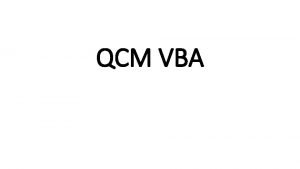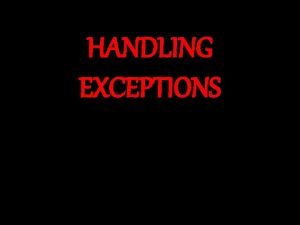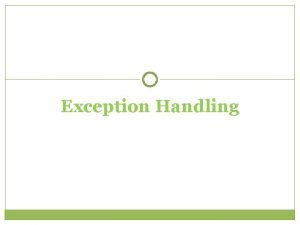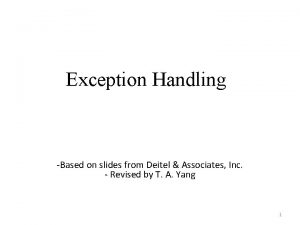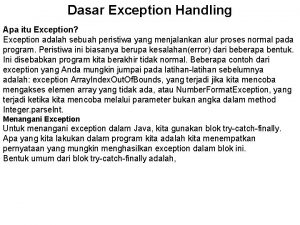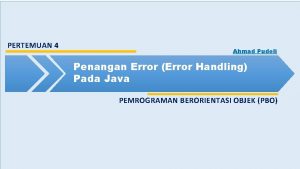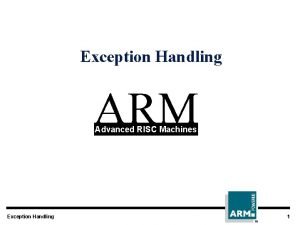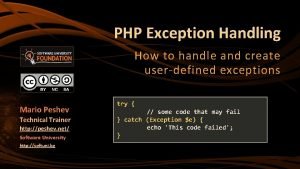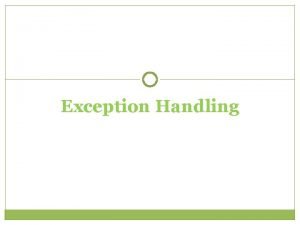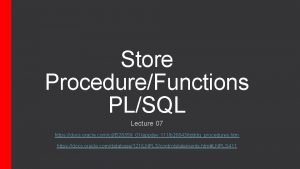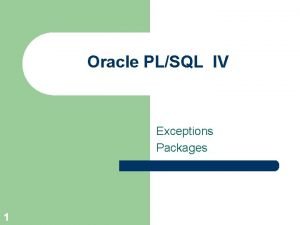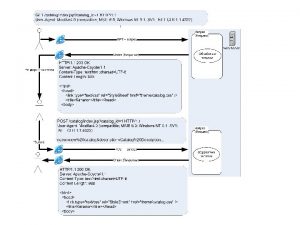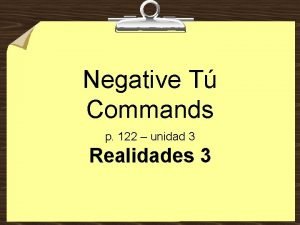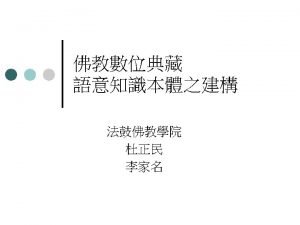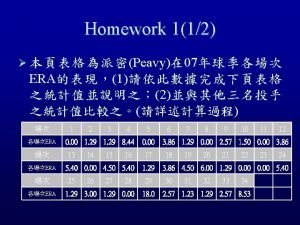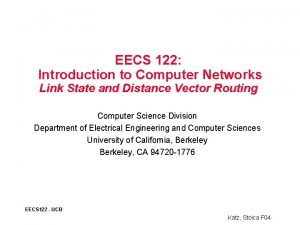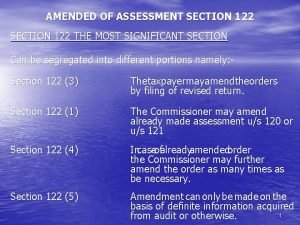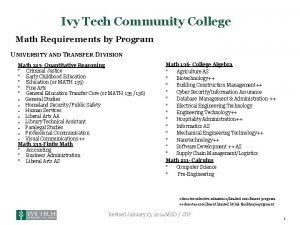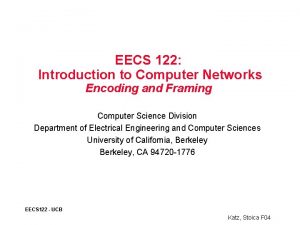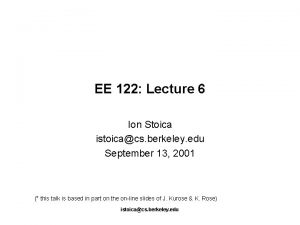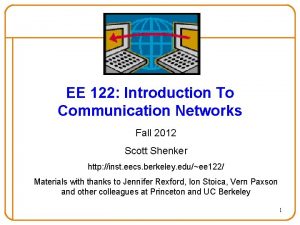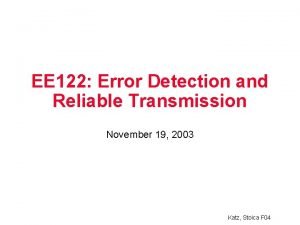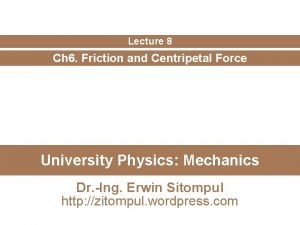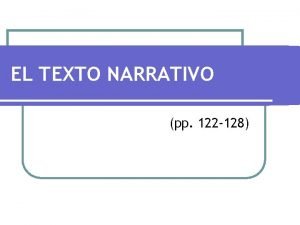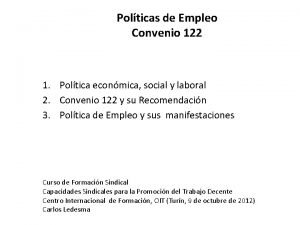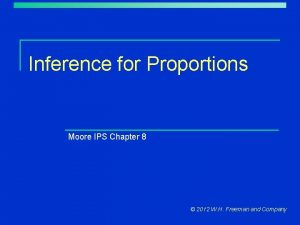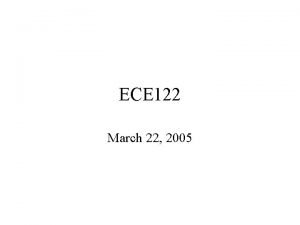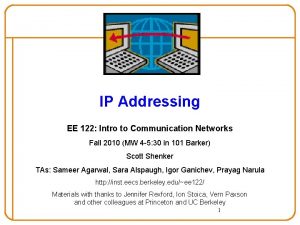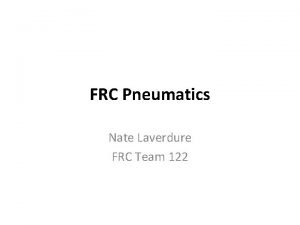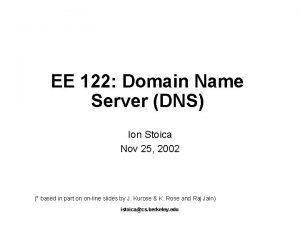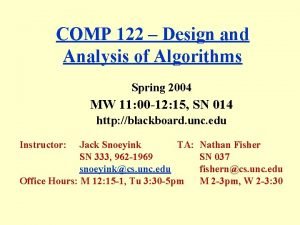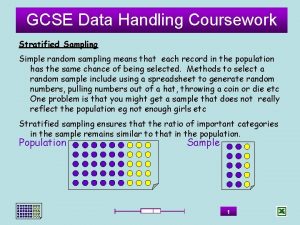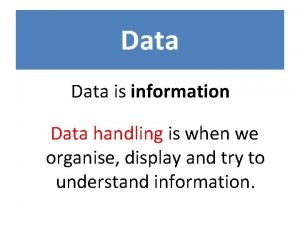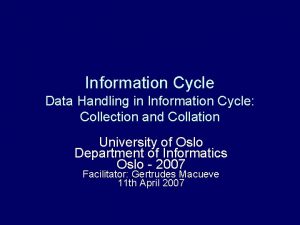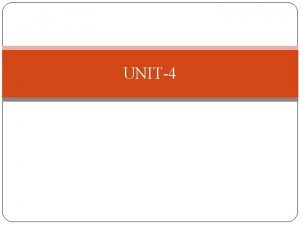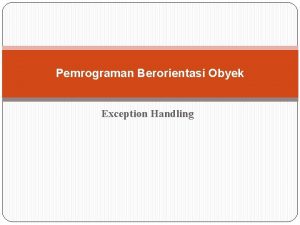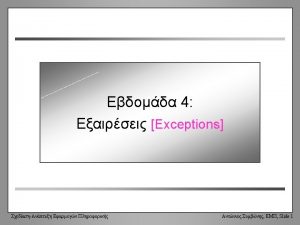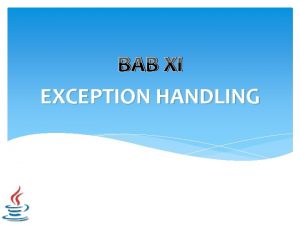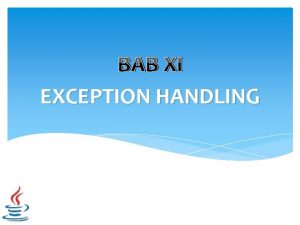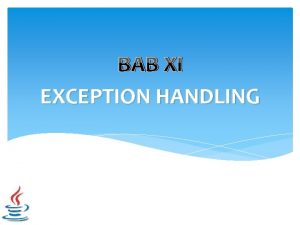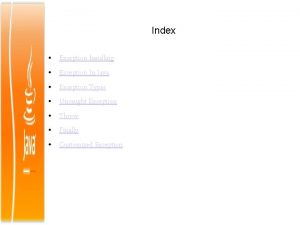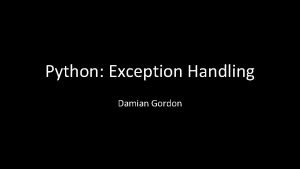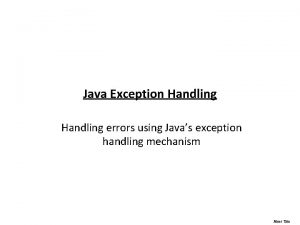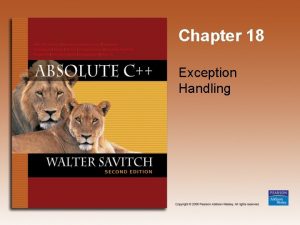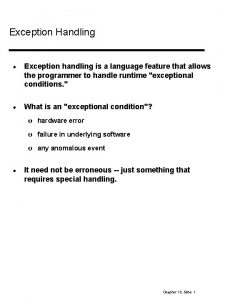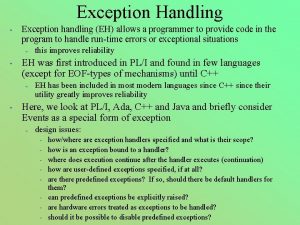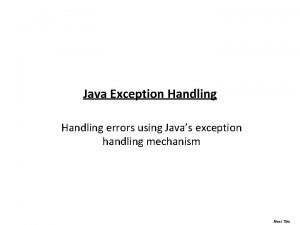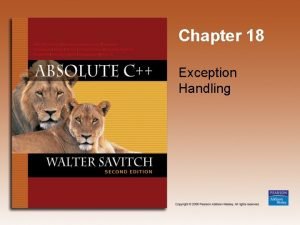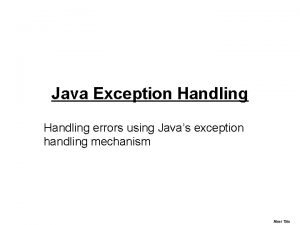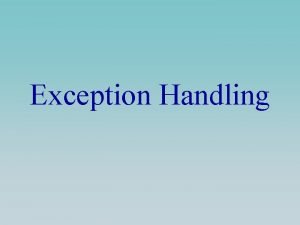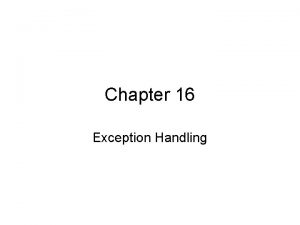Cpt S 122 Data Structures Exception Handling A
























































- Slides: 56

Cpt S 122 – Data Structures Exception Handling: A Deeper Look Nirmalya Roy School of Electrical Engineering and Computer Science Washington State University

Topics n Introduction ¡ ¡ ¡ n Exception Specifications ¡ n Example: Handling an attempt to divide by zero Use try, catch and throw to detect, handle and indicate exceptions, respectively. Rethrowing an exception Processing unexpected and uncaught exceptions Stack unwinding ¡ enables exceptions not caught in one scope to be caught in another

Introduction (cont) n n Constructors, destructors & exception handling Processing new failures ¡ ¡ n Dynamic memory allocation Use unique_ptr to prevent memory leak Exception & Inheritance ¡ Understand the exception inheritance hierarchy

Introduction n An exception is an indication of a problem that occurs during a program’s execution. ¡ n n Exception handling enables to create applications that can resolve (or handle) exceptions. Handling an exception allows a program to continue executing as if no problem had been encountered. Enable to write robust and fault-tolerant programs ¡ deal with problems that may arise and continue executing or terminate gracefully.

Example: Handling an Attempt to Divide by Zero n Let’s consider a simple example of exception handling. ¡ n In C++, division by zero using integer arithmetic ¡ n A common arithmetic problem; division by zero. typically causes a program to terminate prematurely. In floating-point arithmetic, some C++ implementations allow division by zero ¡ positive or negative infinity is displayed as INF or -INF, respectively.

Example: Handling an Attempt to Divide by Zero (cont. ) n In this example, we define a function named quotient ¡ receives two integers input by the user and divides its first int parameter by its second int parameter. n n ¡ the function casts the first int parameter’s value to type double. the second int parameter’s value is promoted to type double for the calculation. function quotient actually performs the division using two double values and returns a double result.

Example: Handling an Attempt to Divide by Zero (cont. ) n n Function quotient tests its second parameter to ensure that it isn’t zero before allowing the division to proceed. If the second parameter is zero, the function uses an exception to indicate to the caller that a problem occurred. The caller (main in this example) can then process the exception ¡ allow the user to type two new values before calling function quotient again. In this way, the program can continue to execute even after an improper value is entered, ¡ making the program more robust.

Example: Handling an Attempt to Divide by Zero (cont. ) n Divide. By. Zero. Exception. h defines an exception class that represents the type of the problem that might occur ¡ n defines the quotient function and the main function that calls it. Function main contains the code that demonstrates exception handling.

Exception Handling an Attempt to Divide by Zero (cont. ) n Define class Divide. By. Zero. Exception as a derived class of Standard Library class runtime_error n Class runtime_error ¡ ¡ ¡ a derived class of Standard Library class exception defined in header file <exception> the C++ standard base class for representing runtime errors.


Example: Handling an Attempt to Divide by Zero (cont. ) n n An exception class that derives from the runtime_error class ¡ define only a constructor that passes an error-message string to the base-class runtime_error constructor. Every exception class that derives directly or indirectly from exception ¡ contains the virtual function what, ¡ returns an exception object’s error message. It is not required to derive a custom exception class Divide. By. Zero. Exception, from the standard exception classes provided by C++. ¡ doing so allows you to use the virtual function what to obtain an appropriate error message. We use an object of this Divide. By. Zero. Exception class ¡ indicate when an attempt is made to divide by zero.

Example: Handling an Attempt to Divide by Zero (cont. ) n n n Function quotient divides its first parameter (numerator) by its second parameter (denominator). Assuming that the user does not specify 0 as the denominator for the division, quotient returns the division result. However, if the user inputs 0 for the denominator, function quotient throws an exception.




Example: Handling an Attempt to Divide by Zero (cont. ) n n n try blocks enable exception handling. The try block encloses statements that might cause exceptions and statements that should be skipped if an exception occurs. The invocation of function quotient can throw an exception, ¡ n n enclose this function invocation in a try block. Enclosing the output statement in the try block ensures that the output will occur only if function quotient returns a result. Exceptions may surface through explicitly mentioned code in a try block ¡ through calls to other functions ¡ through deeply initiated function calls initiated by code in a try block

Example: Handling an Attempt to Divide by Zero (cont. ) n n n Exceptions are processed by catch handlers (also called exception handlers), which catch and handle exceptions. ¡ At least one catch handler must immediately follow each try block. Each catch handler begins with the keyword catch and specifies in parentheses an exception parameter ¡ represents the type of exception the catch handler can process (Divide. By. Zero. Exception in this case). When an exception occurs in a try block, ¡ the catch handler that executes is the one whose type matches the type of the exception that occurred.

Example: Handling an Attempt to Divide by Zero (cont. ) n n n If an exception occurs as the result of a statement in a try block, the try block expires (i. e. , terminates immediately). Next, the program searches for the first catch handler that can process the type of exception that occurred. The program locates the matching catch by comparing the thrown exception’s type to each catch’s exceptionparameter type until the program finds a match. A match occurs if the types are identical or if the thrown exception’s type is a derived class of the exceptionparameter type. When a match occurs, the code contained in the matching catch handler executes.

Example: Handling an Attempt to Divide by Zero (cont. ) n When a catch handler finishes processing by reaching its closing right brace (}), ¡ ¡ n n the exception is considered handled and the local variables defined within the catch handler (including the catch parameter) go out of scope. Program control does not return to the point at which the exception occurred (known as the throw point), because the try block has expired. Rather, control resumes with the first statement after the last catch handler following the try block. This is known as the termination model of exception handling. As with any other block of code, when a try block terminates, local variables defined in the block go out of scope.

Example: Handling an Attempt to Divide by Zero (cont. ) n n n The try block completes its execution successfully (i. e. , no exceptions occur in the try block), ¡ the program ignores the catch handlers ¡ program control continues with the first statement after the last catch following that try block. An exception that occurs in a try block ¡ has no matching catch handler ¡ if an exception occurs in a statement that is not in a try block n the function that contains the statement terminates immediately, n the program attempts to locate an enclosing try block in the calling function. This process is called stack unwinding. ¡ An exception not caught in one scope can be caught in another.

Example: Handling an Attempt to Divide by Zero (cont. ) n n n throw operand is created and used to initialize the parameter in the catch handler. Central characteristic of exception handling: A function should throw an exception before the error has an opportunity to occur. ¡ an exception is thrown within a try block, ¡ the exception is caught by a catch handler that specifies the type matching ¡ catch handler specifies that it catches Divide. By. Zero. Exception objects ¡ this type matches the object type thrown in function quotient. catch handler catches a reference to the Divide. By. Zero. Exception object created by function quotient’s throw statement

Observations n n Catching an exception object by reference eliminates the overhead of copying the object that represents the thrown exception. Associating each type of runtime error with an appropriately named exception object improves program clarity.

When to Use Exception Handling n Exception handling is designed to process synchronous errors, ¡ ¡ ¡ n out-of-range array subscripts, arithmetic overflow (i. e. , a value outside the representable range of values), division by zero, invalid function parameters, unsuccessful memory allocation (due to lack of memory). Exception handling is not designed to process errors associated with asynchronous events ¡ ¡ disk I/O completions, network message arrivals, mouse clicks and keystrokes, occur in parallel and independent of the program’s flow of control.

When to Use Exception Handling (cont. ) n Exception-handling also is useful for processing problems that occur when a program interacts with software elements, ¡ ¡ ¡ member functions, constructors, destructors and classes. Software elements often use exceptions to notify programs when problems occur. enables to implement customized error handling for each application.

Rethrowing an Exception n n It’s possible that an exception handler, upon receiving an exception, ¡ might decide either that it cannot process that exception ¡ it can process the exception only partially. In such cases, the exception handler can defer the exception handling (or perhaps a portion of it) to another exception handler. In either case, you achieve this by rethrowing the exception via the statement n throw; Regardless of whether a handler can process an exception, ¡ the handler can rethrow the exception for further processing outside the handler. The next enclosing try block detects the rethrown exception, ¡ a catch handler listed after that enclosing try block attempts to handle.



Exception Specifications n n An optional exception specification (also called a throw list) enumerates a list of exceptions that a function can throw. For example, consider the function declaration n n int some. Function( double value ) throw ( Exception. A, Exception. B, Exception. C ) { // function body } Indicates that function some. Function can throw exceptions of types Exception. A, Exception. B and Exception. C.

Constructors, Destructors and Exception Handling n n What happens when an error is detected in a constructor? For example, how should an object’s constructor respond ¡ ¡ n if new fails it was unable to allocate required memory for storing that object’s internal representation? The constructor cannot return a value to indicate an error, ¡ ¡ we must choose an alternative means of indicating that the object has not been constructed properly. One scheme is to return the improperly constructed object n ¡ hope that anyone using it would make appropriate tests to determine that it’s in an inconsistent state. Another scheme is to set some variable outside the constructor.

Constructors, Destructors and Exception Handling (cont. ) n The preferred alternative ¡ n Before an exception is thrown by a constructor, ¡ n n the constructor throw an exception that contains the error information. destructors are called for any member objects built as part of the object being constructed. Destructors are called for every automatic object constructed in a try block before an exception is thrown. Stack unwinding is guaranteed to have been completed at the point that an exception handler begins executing. ¡ If a destructor invoked as a result of stack unwinding throws an exception, n terminate is called.

Constructors, Destructors and Exception Handling (cont. ) n If an object has member objects, ¡ ¡ n If an array of objects has been partially constructed when an exception occurs, ¡ n n an exception is thrown before the outer object is fully constructed, destructors will be executed for the member objects that have been constructed prior to the occurrence of the exception. only the destructors for the constructed objects in the array will be called. An exception could preclude the operation of code that would normally release a resource (such as memory or a file), ¡ cause a resource leak. ¡ One technique to resolve this problem is to initialize a local object to acquire the resource. When an exception occurs, the destructor for that object will be invoked and can free the resource.

Observations n When an exception is thrown from the constructor from an object that’s created in a new expression ¡ the dynamically allocated memory for that object is released.

Processing new Failures n The C++ standard specifies that, when operator new fails, it throws a bad_alloc exception ¡ n defined in header file <new>. Two examples of new failing. ¡ ¡ The first uses the version of new that throws a bad_alloc exception when new fails. The second uses function set_new_handler to handle new failures.

Processing new Failures (cont. ) n The output shows that the program performed only four iterations of the loop before new failed and ¡ n threw the bad_alloc exception. Your output might differ based on the ¡ ¡ ¡ physical memory, disk space available for virtual memory on your system the compiler you are using.




Processing new Failures (cont. ) n n The C++ standard specifies that compilers can use an older version of new that returns 0 upon failure. For this purpose, header <new> defines object nothrow (of type nothrow_t), which is used as follows: n n The preceding statement uses the version of new ¡ n double *ptr = new( nothrow ) double[ 50000000 ]; does not throw bad_alloc exceptions (i. e. , nothrow) to allocate an array of 50, 000 doubles. To make program more robust use the version of new that throws bad_alloc exceptions on failure.

Processing new Failures (cont. ) n Function set_new_handler (prototyped in standard header file <new>) ¡ takes as its argument a pointer to a function that takes no arguments and returns void. ¡ This pointer points to the function that will be called if new fails. This provides you with a uniform approach to handling all new failures, regardless of where a failure occurs in the program. ¡ n Once set_new_handler registers a new handler in the program, ¡ ¡ n If new fails to allocate memory and set_new_handler did not register a new-handler function, ¡ n operator new does not throw bad_alloc on failure; rather, it defers the error handling to the new-handler function. new throws a bad_alloc exception. If new fails to allocate memory and a new-handler function has been registered, ¡ the new-handler function is called.




Class unique_ptr and Dynamic Memory Allocation n A common programming practice is to allocate dynamic memory, ¡ ¡ ¡ n n assign the address of that memory to a pointer, use the pointer to manipulate the memory and deallocate the memory with delete when the memory is no longer needed. If an exception occurs after successful memory allocation but before the delete statement executes, a memory leak could occur. The C++ standard provides class template unique_ptr in header file <memory> to deal with this situation.

Class unique_ptr and Dynamic Memory Allocation (cont. ) n n An object of class unique_ptr maintains a pointer to dynamically allocated memory. When an unique_ptr object destructor is called ¡ n Class template unique_ptr provides overloaded operators * and -> ¡ n it performs a delete operation on its pointer data member. an unique_ptr object can be used just as a regular pointer variable. Demonstrate an unique_ptr object that points to a dynamically allocated object of class Integer






Class unique_ptr and Dynamic Memory Allocation (cont. ) n ptr. To. Integer is a local automatic variable in main ¡ n The unique_ptr destructor forces a delete of the Integer object pointed to by ptr. To. Integer ¡ n n ptr. To. Integer is destroyed when main terminates. calls the Integer class destructor. The memory that Integer occupies is released, regardless of how control leaves the block (e. g. , by a return statement or by an exception). Most importantly, using this technique can prevent memory leaks.

Exceptions and Inheritance n Various exception classes can be derived from a common base class ¡ n Divide. By. Zero. Exception as a derived class of class exception. If a catch handler catches a pointer or reference to an exception object of a base-class type, ¡ ¡ it also can catch a pointer or reference to all objects of classes publicly derived from that base class this allows for polymorphic processing of related errors.

Standard Library Exception Hierarchy n n n Exceptions fall nicely into a number of categories. The C++ Standard Library includes a hierarchy of exception classes. This hierarchy is headed by base-class exception (defined in header file <exception>) ¡ ¡ contains virtual function what, derived classes can override to issue appropriate error messages.

Standard Library Exception Hierarchy

Standard Library Exception Hierarchy (cont. ) n n Immediate derived classes of base-class exception ¡ runtime_error and logic_error ¡ both defined in header <stdexcept>, ¡ each of which has several derived classes. Also derived from exception are the exceptions thrown by C++ operators—for example, ¡ bad_alloc is thrown by new ¡ bad_cast is thrown by dynamic_cast ¡ bad_typeid is thrown by typeid. ¡ bad_exception in the throw list of a function n if an unexpected exception occurs, function unexpected can throw bad_exception rather than terminating the program’s execution

Standard Library Exception Hierarchy (cont. ) n Class logic_error is the base class of several standard exception classes that indicate errors in program logic. ¡ ¡ n n For example, class invalid_argument indicates that an invalid argument was passed to a function. Proper coding can, of course, prevent invalid arguments from reaching a function. Class length_error indicates that a length larger than the maximum size allowed for the object being manipulated was used for that object. Class out_of_range indicates that a value, such as a subscript into an array, exceeded its allowed range of values.

Standard Library Exception Hierarchy (cont. ) n Class runtime_error is the base class of several other standard exception classes that indicate execution -time errors. For example, ¡ ¡ class overflow_error describes an arithmetic overflow error (i. e. , the result of an arithmetic operation is larger than the largest number that can be stored in the computer) and class underflow_error describes an arithmetic underflow error (i. e. , the result of an arithmetic operation is smaller than the smallest number that can be stored in the computer).
 Que signifie
Que signifie Exception handling pl sql
Exception handling pl sql Exception handling in vb
Exception handling in vb Exception handling in java
Exception handling in java Dasar exception
Dasar exception Php exception handler
Php exception handler Exception handling pada java
Exception handling pada java Arm exception handling
Arm exception handling Exception handling in ada
Exception handling in ada Php exception handling
Php exception handling Exception handling in vb net
Exception handling in vb net Dbs311 assignment 2
Dbs311 assignment 2 No data found exception in oracle
No data found exception in oracle Http data source exception
Http data source exception Homologous structure
Homologous structure Mandatos negativos con tú (p 122)
Mandatos negativos con tú (p 122) Nec article 810
Nec article 810 Http://122
Http://122 Homework 122
Homework 122 Eecs 122
Eecs 122 Ece 122
Ece 122 Notice to amend assessment
Notice to amend assessment Ivy tech finite math
Ivy tech finite math Eecs 122
Eecs 122 Nec 250 122
Nec 250 122 Psalm 122 passion translation
Psalm 122 passion translation Psalms of ascent background
Psalms of ascent background Ee 122 berkeley
Ee 122 berkeley Ee 122
Ee 122 Ee 122
Ee 122 Classes of airspace
Classes of airspace Psalm 68 5-6
Psalm 68 5-6 50000/122
50000/122 François quesnay
François quesnay What is 757 rounded to the nearest ten
What is 757 rounded to the nearest ten Psalm 69:7
Psalm 69:7 Nrs 122
Nrs 122 A traffic light weighing 122 n hangs from a cable
A traffic light weighing 122 n hangs from a cable 122+105
122+105 Texto en tercera persona
Texto en tercera persona Convenio 122 oit
Convenio 122 oit You buy a package of 122 smarties
You buy a package of 122 smarties Ece 122
Ece 122 Ee 122
Ee 122 Cartel de horario de trabajo lottt
Cartel de horario de trabajo lottt Psalm 122:1-9
Psalm 122:1-9 Jarak kota a ke b adalah 85 km suatu peta mempunyai skala 1
Jarak kota a ke b adalah 85 km suatu peta mempunyai skala 1 In ip addressing, an address beginning with 122 is
In ip addressing, an address beginning with 122 is Team 122
Team 122 Ee 122
Ee 122 Comp122
Comp122 Stratified sampling gcse
Stratified sampling gcse Data handling song
Data handling song What is the information cycle
What is the information cycle Handling data hazards
Handling data hazards Hierarchy of thread class in java
Hierarchy of thread class in java Innerexception: system.io.directorynotfoundexception
Innerexception: system.io.directorynotfoundexception
